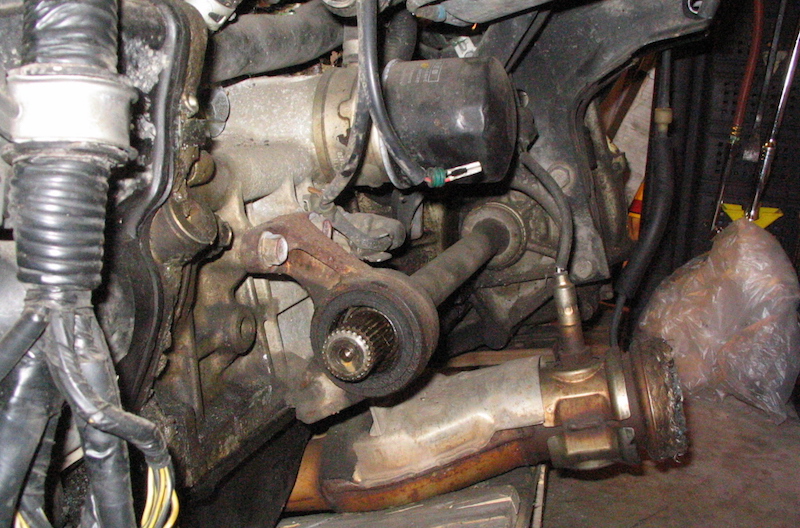You probably know that an illuminated Check Engine Light (CEL) means somewhere on your vehicle's engine or transmission is a sensor that's registered a reading that's outside of normal parameters. When that happens, the powertrain control module (PCM) stores that reading as a trouble code, illuminating the CEL.
The current system of onboard diagnostics (OBD-II) means that there's a diagnostic connector, a 16-pin connection underdash on the driver's side. It's a simple matter of hooking up a code reader to this diagnostic port to access any trouble codes stored in the PCM. The advent of OBD-II diagnostics took much of the guesswork out of troubleshooting, as it can quickly point you in the right direction to sniff out a problem.
This can get tricky, though, in instances where the sensor issue might trigger several trouble codes. That's where it's necessary to do some deduction and read between the lines to get to the bottom of the problem, rather than just replacing parts.
It's worth mentioning that the first step for any CEL problem should be to clear any trouble codes in the PCM ,take the vehicle for a test drive to see if the trouble codes return and the CEL lights up again.

P0202 — What It Means
Your engine's fuel injectors are activated by a solenoid, which in turn is activated by a transistor called a "driver." Each cylinder's injector is supplied with power from the battery, at one of two terminals. When it's time to spray fuel into the cylinder, the PCM grounds the other terminal and completes a circuit, which activates the driver and solenoid to open the injector. This code could be due to a bad injector, an open or short connection, an intermittent open or short, a bad ground or even a bad PCM (though rare).
Note: on V6 and V8 engines, look for the cylinder bank that is offset slightly forward from the other and that bank will be the odd-numbered cylinders.
Drivers commonly use either the "saturated switch" or "peak-and-hold" designs. With a saturated switch, the PCM supplies maximum voltage from the time the injector's needle valve opens until it shuts again. A peak-and-hold design supplies a pulse of maximum voltage, then drops the voltage to just enough to keep the valve open.
Code P0202 indicates an injector misfire on cylinder 2, with the PCM commanding the injector to open but not recognizing a change in electrical current that would indicate the injector fired. This trouble code is similar to P0201, P0203, P0204, P0205, P0206 and P0207, and P0208, and may be accompanied by one or more of those codes.
Symptoms
These symptoms can vary by year/make/model:
- Rough running
- Stalling
- Misfire
- Poor fuel economy
- Limp-in mode
- Rich-running or lean-running
- Hard-start condition
What Happens If I Ignore It?
If your vehicle is in limp-in mode, you may have a top speed that's limited to about 40 mph or less. Chances are that if you have a P0202 OBD-II trouble code, your vehicle will be running poorly enough that it won't be very drivable. In any event, ignoring a P0202 code for long can lead to further engine damage.
Possible Fixes
- Check all wiring and connections for looseness or damage; perform wiggle tests while the engine is idling.
- Check for other misfire-related codes in the PCM. Codes P0301 through P0308 would all be misfire-related but more general, pointing to a problem with the coil pack, spark plug, etc.
- Once you've determined which cylinder is misfiring, you can easily check by using a test light (aka "noid light"). Disconnect the injector and plug the noid light into the connector. If the noid light flashes as you crank the engine, the control circuit for that injector is working properly. If it doesn't flash, or stays on the entire time, there's a problem.
- To test the circuit for power from the PCM, use a test light and attach one lead to ground. Attach the other to the B+ pin on the connector. The light should illuminate. If the test light isn't lighting up or lights weakly or intermittently, use your multimeter for a voltage check as well.
Testing a circuit has the potential to get confusing. Remember that your best bet is to keep a cool head, use some critical thinking/deduction and keep it simple. Isolate the circuit into segments to rule out problems, starting with whatever is easiest and quickest for you to check. In this case, that means starting with a visual inspection and then moving on to the injector itself. If you need to replace a fuel injector, we've got you covered there, too.








